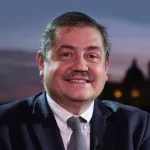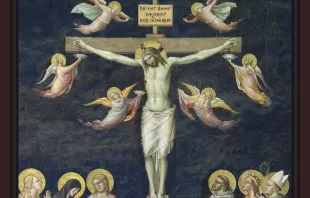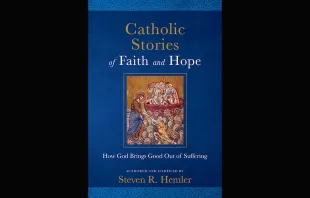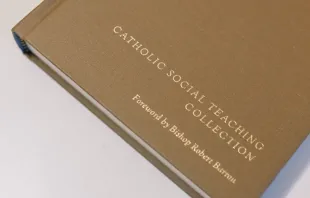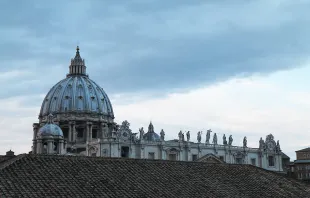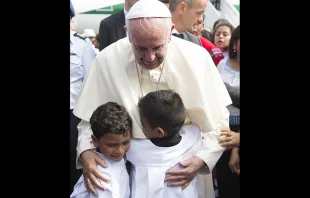Articles by Alejandro Bermudez
The strange, fascinating story of a Catholic book no one should miss
May 3, 2021 / 09:55 amThe story of The Vulnerary of Christ could have been written by a Catholic-friendly Dan Brown. How it ended up being printed and distributed by Angelico Press is not a novel, but a true story.
Catholic Stories of Faith and Hope: How God brings Good out of Suffering
Apr 19, 2021 / 20:19 pmWhy do bad things happen to good people? It’s a dilemma that has haunted every community that has believed in a just God.
Want to know more about Catholic Social Teaching? Here’s a primer
Apr 9, 2021 / 13:42 pmA Catholic president who prays the rosary and receives Holy Communion, but opposes fundamental teachings of the Catholic Church has sparked a debate and – one hopes – renewed interest in the social teaching of the Catholic Church.
Annotating the Scriptures? This new Bible will provide plenty of room… and inspiration
Mar 31, 2021 / 14:54 pmMost of us Catholics have a love relationship with that worn down, annotated, highlighted and dog-eared Bible. That unique Bible is not only the Word of God in our hands, it is also a sign of our spiritual journey, a testimony of our most intimate conversations with God.
Papal Mass in Erbil 'nothing short of a miracle'
Mar 5, 2021 / 11:19 amWhen Vida Hanna was told by the Archbishop Bashar Warda of the Chaldean Archeparchy of Erbil that Pope Francis was coming to Iraq, she thought to herself it was just another rumor.
Some Catholic pundits say pro-life voting is problematic, but give abortion advocates a pass
Aug 9, 2016 / 00:00 amAs it usually is in election years, abortion is now very much a political issue in 2016, and Catholics are playing a key role in how it is discussed. Last week, speaking to about 2,500 Knights and family members, 100 bishops including a dozen Cardinals, and a worldwide TV audience, Knights of Columbus leader Carl Anderson urged Catholics not to vote for any candidate who was pro-abortion. Others took the opposite view. Sister Simone Campbell of “Nuns on the Bus,” and Planned Parenthood both doubled on support for legalized abortion in this election cycle. Anderson laid out his case on Aug. 2. He cited words he first spoke in 2008, saying: “We need to end the political manipulation of Catholic voters by abortion advocates. It is time to end the entanglement of Catholic people with abortion killing. It is time to stop creating excuses for voting for pro-abortion politicians.” He added, “We will never succeed in building a culture of life if we continue to vote for politicians who support a culture of death.” Though Anderson’s comments on abortion made up just a few minutes of his hour and a half speech, even that was seen as too much for some commentators on the Catholic left, who quickly attacked his words. In an opinion piece thinly disguised as a news story, David Gibson of Religion News Service made the case that Pope Francis does not see the right to life as an absolute value. In an attempt to paint the pope a relativist, he cited a CNA piece entitled: “All values are non-negotiable, Pope says in new interview.” Unmentioned by Gibson was Francis’ recent comment that, “The commandment, ‘Thou shalt not kill’ has absolute value.” Also unmentioned was the Holy Father’s previous public support for Knights of Columbus initiatives to defend life. And though Anderson said nothing about who people should vote for, Michael Sean Winters attacked as well – not on the substance of the argument – but on the basis that it must somehow be partisan. Among Winters' issues was that Anderson didn’t mention Laudato Si (he did) and that he didn’t care about people south of the Rio Grande as much as those in the Middle East. (Leaving aside the lack of genocide south of the Rio Grande, Winters apparently missed the portion of Anderson’s speech highlighting a recent visit to Mexico during which he personally helped dozens of physically handicapped people). As to what that portion of his speech meant, Anderson told CNA: “My comments apply to candidates of both parties and to every political race. To draw partisan inferences from those statements may reveal more about the partisanship of those drawing the inferences than about what I said.” Interestingly, while the idea that Catholics shouldn’t vote for pro-abortion politicians seemed to give these commentators the vapors, neither Gibson nor Winters had anything negative to say about Sister Simone Campbell, who came out in support of legalized abortion last week. The head of the liberal advocacy group, “Nuns on the Bus,” who addressed the Democratic National Convention in 2012, Sister Simone Campbell gave an interview Aug. 1 on the radio show “Democracy Now!” She said: “I don’t think it’s a good policy to outlaw abortion.” She argued that economic development for women was a better focus. As recently as last month Sister Simone had chided the Democrats for their opposition to the Hyde Amendment, and worried that the Democrats could lose if they moved their “agenda to the far left.” The abortion industry is also in full election mode, something that seems of little interest to those who sought to politicize Anderson’s remarks. Reports last week indicate that Planned Parenthood will register people to vote at the organization’s clinics and other locations. It will also remind those who it registers to vote as the election nears. Though technically non-partisan, the campaign “will likely benefit Democrats and Hillary Clinton,” according to the Huffington Post, which broke the story. This will be in addition to the $20 million that Planned Parenthood plans to spend this year to support pro-abortion candidates – Hillary Clinton for president, and various candidates for the Senate as well. This is according to Think Progress, which also reported that Planned Parenthood is “training a political army” of grassroots activists. More than 1,000 were already trained by the group in Pittsburgh this spring. How Catholics will react to all of this remains to be seen, but recent polling by Marist (commissioned by the Knights of Columbus) indicates that practicing Catholics are pro-life in even greater numbers than Americans on the whole.
The scandal that wasn't
Nov 4, 2015 / 00:00 amTwo books are about to hit the shelves this week, supposedly testing Pope Francis' Vatican's capacity to withstand fresh scandals. The first and most important, “Merchants in the Temple” is authored by Italian journalist Gianluigi Nuzzi, author of the 2012 blockbuster “His Holiness,” which sparked the scandal known as the “Vatileaks” and resulted in the conviction of Pope Benedict XVI’s butler, Paolo Gabriele, precisely for leaking Nuzzi the documents. The second book, “Avarice: Documents Revealing Wealth, Scandals and Secrets of Francis’ Church,” by Italian journalist Emiliano Fittipaldi, has the less pretentious attempt to convince the world that, surprise! The Vatican has money. Reading “Merchants of Truth” immediately brings to mind George Weigel’s observation about some authors in Italy: “The border between fact and fiction in Italian journalism is, in fact, not a border, but a membrane, across which all sorts of material passes in both directions.” Take a look, in fact, Nuzzi’s opener: “It is the afternoon of September 12, 1978. Pope John Paul I, after only eighteen days of his pontificate, discovers that a powerful Masonic lobby with 120 members is active within the Curia... He then announced his plans for dramatic changes at the Roman curia to Cardinal Villot, but... (t)he next day, at dawn, Sister Vincenza Taffarel finds the Pontiff’s lifeless body in his bed.” The book, in fact, which according to Nuzzi “tells the story of that war— through documents that have never before been made public— offering proof of a gigantic, and seemingly relentless, malfeasance that the Pontiff is challenging with singular courage and determination,” is a convoluted, sometimes boring novel-style tale that intertwines the assassination of Pope Albino Lucciani with free masons among cardinals, gay lobbies, Italian mafia, international corporations and bugs planted inside the Vatican offices. Using –and abusing— allegedly secret documents and taped conversations, Nuzzi makes the case –already well known—that Pope Francis is determined to put an end to the practice the author describes: “For too long, in an incredibly facile and superficial manner, millions have been disbursed to pay for unbudgeted jobs that were executed without the required oversight and with ridiculously padded invoices. Many have taken advantage, pocketing even the donations of the faithful, the offerings that were supposed to go to the needy.” The second chapter, regarding the making of saints, opens with praising words toward Msgr. Lucio Ángel Vallejo Balda and Francesca Chaouqui, precisely the two individuals that last weekend were arrested by the Vatican for leaking confidential documents to the press –maybe to Nuzzi himself. Vallejo Balda will be presented as a hero all along the book, especially in chapter nine. Nuzzi clearly shows his lack of knowledge of Vatican proceedings, complaining that "making a saint" has an average price tag of 500,000 Euros. “We then have to consider the costs of all the thank you gifts required for the prelates who are invited to festivities and celebrations held at crucial moments in the process, to say a few words about the acts and miracles of the future saint or blessed.” Nuzzi clearly ignores the expensive nature of theological, moral, historical and medical investigations required to make sure that a saint has the necessary “heroic virtues” and later that a miracle to his intercession is corroborated. And most importantly, ignores that no postulator of a saint, not even the ones of Archbishop Oscar Romero, have ever complained about the cost of the process. In the third chapter the author aims to describe the murky management of Peter's Pence –mostly a fair claim— and to tell the "lavish" style of too many cardinals: “The cardinals of the Curia reside in princely dwellings of 400, 500, even 600 square meters.” It is true that, as in many other financial areas, the Vatican real estate is in need of reform. But Nuzzi ignores that although some Cardinals have indeed scandalized with the lavishness of their quarters, many other Cardinals and Vatican officials are forced to live in gigantic apartments built centuries ago that they never chose, and sometimes can barely afford. For example, after the signing of the Lateran pacts that made peace between the Vatican and the Italian state, Mussolini built the colossal Vatican Building of San Calisto, at the Trastevere, with apartments for cardinals so large that many can't afford to cool it down during the summer or warm it up during the winter. And that's barely the Cardinals' fault. In the same vein, Nuzzi tries to make the case of how much the Vatican would earn if it rented their real estate property at market prices rather than at the discounted prices they give to curia members. The argument is ridiculous. Vatican officials make significantly low salaries and receive lousy medical insurance and retirement plans. The only advantage the Vatican can offer to them, is a reduced rent, as well as gasoline, food, home products and medicines free of the Italian taxes. In order to rent Vatican property at market prices, the Vatican should have to pay competitive salaries, which at the end would be far more expensive. Nuzzi’s book is not lacking of genuine claims, like the fact that, until the recent reforms only 20 cents of each Euro from Peter's Pence reached the poor; or that there was a major mismanagement of very large amounts of money at different Roman dicasterios –consequence of corruption, overspending and accounting incompetence; or that there are major holes in the Vatican's pension funds –to the tune of 800 million Euro. Nevertheless, most of the book reads as a never ending string of gossip about the peccadilloes of little-known monsignors who live a lavish, while not utterly corrupt, life; most of which has already been material of abundant coverage in the Italian press. The author also adds endless internal memos and “confidential” letters to make the sad point: corruption, mismanagement and sheer incompetence abounds… without ever acknowledging that the financial reform, even if far form completed, is one of the most evident successes of Pope Francis’ pontificate. In chapter 10, Nuzzi does everything possible to discredit the record of Cardinal Pell in Australia, even disfiguring or making up facts of his past. But the author has to surrender to the fact that the Australian Cardinal is loyal to the Pope's desire for reform and that he has accomplished some victories, although not all the ones the author believe he should have. In the last chapter the author asks if Pope Francis will resign. The issue of a possible Francis resignation is never mentioned in the chapter, except for the title. But he does raise the question: “Will the Pope Win the Battle? It is hard to answer this question with any certainty. I believe that his project cannot be deferred or avoided, but it is hard to argue that he will succeed in bringing to completion his ambitious mission.” In short, way too many words conclude what everyone knows, without the need to read an endless stream of secret, utterly boring memos.
Francis in South America...or the Pope that wasn't
Jul 17, 2015 / 00:00 amThe coverage that most media outlets gave to the recent trip of Pope Francis to South America seems to beg the question: Can the real Francis please stand up? Let me explain: the Pope delivered a total of 24 speeches and homilies during his eight day trip to Ecuador, Bolivia and Paraguay. Six of them – three addressed to political authorities and another three to representatives of civil society – dealt with political or economic issues. One in particular, the one delivered to the meeting of popular movements in Bolivia, was singled out by most of the media as the most representative of the trip. But was it? From the perspective of that single speech and the ensuing coverage, the Pope’s trip looked to many like the populist tour of a political leader almost obsessed with grandstanding on climate change or economic justice. But in reality, Francis’ trip was fundamentally pastoral, more oriented at spiritually nurturing the adoring, laughing and weeping crowds that gathered by the millions to listen to someone they mostly see as the Vicar of Christ rather than a mere leader among the nations. “Pope calls Ecuadorean Catholics to imitate Mary,” or “Pope consecrates Paraguay to the Immaculate Heart of Mary” are not headlines the press will run. But if used, they would have much better summarized what actually happened during the Pope's visit and, most importantly, what really moved 1.2 million people to stand for a 2-hour long Mass in 100 degrees under the sun in Guayaquil (Ecuador), or 1.3 million on three inches of wet mud in Ñu Guasú (Paraguay.) Addressing the challenges of daily life, Francis said at the Samanes Park in Ecuador: “It is in the family when we learn how to ask permission without overwhelming the other person, how to say ‘thank you’ as an expression of a genuine appreciation of the things we receive, to dominate aggressiveness or voraciousness, and in it we also learn to ask for forgiveness when we hurt someone or we fight… because in all families there is fighting, the important thing is to always ask for forgiveness.” “Be patient, be hopeful, do as the Virgin Mary: pray, act and open your heart, because the best wine is yet to come,” he said upon reflecting on how to apply the passage of the Wedding of Cana to daily Christian life. Most notably, also in Ecuador, he said off-the-cuff: “I think I have to tell you this, as a message from Jesus. All of your spiritual richness that you Ecuadorians have, all this piety and depth come from having the courage – because those were hard times – of consecrating the nation to the Sacred Heart of Jesus, to that divine and human heart who loves us so much.” Ecuador was the first nation in the world to be officially consecrated to the Sacred Heart of Jesus by its political authorities. The consecration was made by Catholic president Gabriel García Moreno in 1874. After his re-election for a third term, he was assassinated in 1875 by a machete-wielding group of freemasons enraged by the consecration of the nation to the Sacred Heart. Garcia Moreno remains a controversial figure in Ecuador's history. For practicing Catholics, he is a martyr of the Sacred Heart of Jesus; for many others, he is the example of a fanatic politician who did not respect the separation between church and state. Pope Francis disregarded the controversy to highlight an episode of Ecuadorean Catholic history that even the local bishops prefer not to mention. And those were not the only words that could have enraged those who believe that Latin America needs to be more “secular” and less “Catholic.” “We have come from different places, regions, towns, to celebrate the presence of God among us. We left our homes and communities hours ago so that we can be together, as the Holy People of God. The cross bring to us the memory of all the communities born in the name of Jesus in this land, of which we are heirs,” Francis said in Bolivia, reaffirming the nation's Catholic identity. He would also say to the inmates of Palmasola, one of the most dangerous prisons in South America, regarding his presence among them: “Who is before you? I would like to answer this question with a certitude of life, a certitude that has branded me for life. A man that was and is saved from his many sins. And thus I introduce myself. I don’t have much to offer you, but what I have and love I give you: Jesus Christ.” And on the public presence of the image of the Virgin Mary in Latin America he said at the Paraguayan Marian shrine of Caacupé: “María is and has been in our hospitals, in our schools, in our homes. She has been and is in our working places and our roads. Has been and is in at the table in our homes. Has been and is in the formation of our country, making us a Nation. She is in the glance of an image, a tiny holy card or a medal. And under the sign if the Rosary, we know that we are not alone, that She is with us.” And thus expressed his vision of Christian communities during the Mass at Ñu Guasú: “How beautiful it is to imagine our parishes, communities and chapels where Christians are together, not with closed doors but as true places of encounter with other human beings and with God.” Pope Francis also translated to the youth in Paraguay a page of classic Jesuit spirituality: “San Ignatius says that the devil, in order to recruit players for his team, promises honor, glory and power. He promises that you will be famous… but the devil is a 'smoke-seller.'” His alternative to such temptation? “Let’s be friends the way Jesus was. Not to remain in our small group, but to go out, in the field, to make more friends. To communicate Jesus’ love all over the world, wherever you are, in the workplace, playing sports, via WhatsApp, on Facebook or Twitter.” And, off-the-cuff again, to 250,000 youth gathered along the shore of the Paraguay river: “We want Young people that are strong, full of hope and fortitude, Why? Because they know Jesus, because they know God, because they have a free heart.” “A free heart!” Paraguayan kids cried loudly and in unison during the emotional, final meeting of his trip. During the long farewell, Pope Francis asked the youth to repeat key ideas several times, improvised, joked, and confided personal reflections motivated by the testimonies of three young Paraguayans. There were some 250,000 kids. Much more than the some 500 who listened to his discourse on economic issues. Pope Francis did express his distrust for capitalism and his concern for those “discarded” by the prevalent economic systems. But to reduce his trip to a political message would be equal to confuse the massive pilgrimages to Marian shrines that Cardinal Bergoglio presided as Archbishop, with a political march. They are dramatically different. So were the real trip and its coverage.
A meeting in Managua – liberation theology 30 years later
May 15, 2015 / 00:00 amThe earthquake that devastated the city of Managua in 1972 changed the capital of Nicaragua forever. Many areas were so utterly destroyed, that they were abandoned for good. Even today, more than 40 years later, it still looks like a post-apocalyptic city, with the old colonial cathedral and entire neighborhoods abandoned and overgrown. Managua was therefore a surprisingly small city when the Sandinistas took control in 1979 to start their liberation theology utopia in Latin America. The Sandinista revolution, in fact, was not only the defeat of one bloody dictatorship. It was the dawn of another, this one hostile to the United States and friendly to the Soviet Union. It also represented the dream of liberation theologians, for it was their opportunity to put their theology into action. These theologians really were in control. It is well known that the Sandinistas, against the explicit wishes of Pope John Paul II, appointed three liberationist Catholic priests – Ernesto Cardenal, Miguel D'Escoto and Fernando Cardenal – as ministers in the Sandinista government. Less known was that la crème de la crème of liberation theology in Latin America – Gustavo Gutierrez, Leonardo Boff, Juan Luis Segundo, Jon Sobrino, Pablo Richard, Ignacio Ellacuría and many others – became a de facto advisory board of the Sandinista government. Their constant presence in Nicaragua was not accidental: at the end of the day, the Sandinista Revolution was their revolution, the opportunity not only to create a new type of government and a new type of society, but also their dreamed of a new “popular church.” The Sandinistas – followers of the alleged KGB agent “GIDROLOG” (Carlos Fonseca) (1) – quickly got into bed with the Soviets, who assigned East Germany as the country's guardian angel. Already feared and hated in Europe, the Stasi set out to replicate itself in Nicaragua. Nicaragua had a government run by liberation theology priests, and guided by a liberation theology braintrust. It was a government that sent all its high level – and many of its mid-level officials – to East Berlin for Communist indoctrination and other training, and allowed the Stasi to build for Nicaragua a secret police network. Totally dependent as they were on East German money, aid, and education, and on Czechoslovakian and Bulgarian bullets, guns and truncheons (8,000 of them), are we to believe the theologians didn't know, or is it that they didn’t care what it took to build their utopia? (2) The question is now especially relevant 25 years after the Soviet bloc lost the Cold War. Last week, Lt. Gen. Ion Mihai Pacepa, the highest ranking defector from the Eastern bloc, told Catholic News Agency that the KGB “created” liberation theology. (3) Some have howled in protest, but with heated opinions – not evidence. (4) But Pacepa's assertion has also been made by Western intelligence sources going back to 1981. (5) He is not alone in this shocking claim. It's abundantly clear that even the best case scenario for Pacepa’s detractors is a situation like that in Nicaragua – where KGB and Stasi “advisors” funded and supplied material support for their friends, the liberation theologians, who were all too willing to take it. If the Soviet bloc wasn't the mother of liberation theology, it was certainly a sinister stepmother, enlisting Catholics in a geopolitical cause and inviting them to sell their souls for funding and support. Only the naïve can disregard the mountain of evidence connecting liberation theology with Soviet action in the region. This evidence points to two worrisome realities: one, that the disinformation about the nature of this theology still continues; and second, that the extent of the success – or one might say, damage – caused by liberation theologians could have never been accomplished without direct Soviet assistance. But, for the ideologically motivated, the past is forgotten as a new narrative takes hold, built, as in the Cold War, on disinformation. How else is it possible for a movement long considered passé to suddenly claim not just victory and new influence, but Pope Francis as their champion? Of course some of the media are giddy over the prospect, running headlines like “Liberation theology finds new welcome in Pope Francis' Vatican” and “Pope declares Oscar Romero, hero to Liberation Theology, a martyr.” (4) I personally got to know Archbishop Romero, and I nearly wrote a biography of him. So I am not anti-Romero – precisely because such headlines don’t do him justice. But for someone like me who knew in the 1970s of this theology's Marxist roots, it is déjà vu. Former advocates of overt Marxist revolution now claim that liberation theology was never Marxist – and then they claim the support of Pope Francis. The wishful thinking results in these claims being reported – unquestioned – by the media. It’s not that simple. Writing the preface for a book in 2005, Cardinal Bergoglio wrote of Liberation Theology: “After the collapse of 'real socialism,' these currents of thought were plunged into confusion. Incapable of either radical reformulation or new creativity, they survived by inertia, even if there are still some today who, anachronistically, would like to propose it again.” (6) Hardly a ringing endorsement. Nevertheless, liberation theologians have seized on the Pope’s concern for the poor to try to clear themselves and rise from the dustbin of history. But history is not on their side. And mercifully neither is the money and support they once had from the Eastern bloc. As for the history, Pacepa is not the only one who says that the Soviet Union saw a weapon in liberation theology that they believed would turn the tide in Latin America against the United States and the West. His version of events is supported – in whole or in part – by many other sources. The infiltration of the World Council of Churches (WCC) and establishment and control of the Christian Peace Conference (CPC), for instance, is documented conclusively among other places in the Mitrokhin Archive, a wealth of material smuggled to the West by KGB archivist Vasili Mitrokhin, and published by Cambridge University Professor Christopher Andrew. (7) Memos from the archives of the Soviet Union and East Germany have also revealed clear Soviet-bloc support of liberation theology – and rage at the opposition it encountered from John Paul II and Joseph Ratzinger. This isn't fiction, it was Soviet policy, now available for anyone interested to read for themselves. There is a 1984 Soviet memo to this effect published by Prof. Andrew, (7) as well as similar documentation from the Stasi archives compiled by John Koehler, former AP bureau chief in both Bonn and Berlin. (7) The memos undeniably indicate a protective interest in liberation theology's success and lay out a retaliatory campaign to do everything possible to undermine John Paul II's Vatican for his opposition to the communist program – including liberation theology. Western intelligence also saw this pattern. Former NSA Director Lt. Gen. William Odom wrote in his book On Internal War that “tactical approaches to religion and churches have also appeared in the Soviet pattern. Liberation theology in Latin America and the Philippines is an example.” (9) And supporting Pacepa's thesis is an article in the 2009 International Journal of Intelligence and Counter-Intelligence by former CIA agent Robert Chapman, assigned to Latin America during the Cold War. Like Pacepa, he says the Soviets created and disseminated liberation theology through the WCC. (10) Pacepa's claims about Soviet infiltration of the Medellin conference are also plausible. It was not the majority of bishops at Medellin who pushed this type of theology. It was primarily two (11) – both well-known socialists. One was Brazilian Bishop Helder Camara of Olinda and Recife (whose process of beatification has been recently opened in his Brazilian diocese). Known as “Camara the Red,” he was a hero of the Soviet press, who famously supported socialism. (12) The other earned his own entry in FBI's Terrorist Photo Album. He was Bishop Sergio Mendez Arceo and his file (as quoted by a detractor of the FBI's methods) noted: “He runs from his diocese a network of nuns and priests and lay people that are friendly to the FDR-FMLN of El Salvador and the FLSN of Nicaragua. They collect intelligence, buy and sell guns and serve as couriers for the communist guerrillas of El Salvador. Mendez Arceo has participated in [several conferences] in which the Catholic bishops proposed the Liberation Theology option for the poor. This new theology proposes a merging of Christianity and Marxism-Leninism. CIA Mexico reports contacts between Arceo and KGB-DGI agents. … Money collected at meetings is sent to Mendez Arceo for guns for the FDR-FMLN…” (13) Far from being non-Marxist, this theology was cozy with communism and can only be resurrected by erasing its direct connection to the violent and bloody organizations with whom it worked: the Sandinistas in Nicaragua, the Shining Path in Peru, or the National Liberation Army in Colombia. Only the partisan or ignorant could deny that the Soviets and liberation theology were closely connected. To say that the connection is irrelevant because this theology would have developed anyway due to non-Soviet related, “endogenous” reasons; is historically irresponsible. Whatever one may believe about the specifics, it is undeniable that the Soviets saw liberation theology as something politically useful to their cause – and that they promoted and defended it as if it were their own. Furthermore, it is not irrelevant that prominent liberation theologians were connected to the WCC and CPC. Nor is it impossible that the Soviet-infiltrated WCC could have been in a position to do what Pacepa and the others say it did. In fact, in the early 1960s, the Soviet-infiltrated WCC sponsored the development of “a theology of revolution” by ISAL, a Latin American Protestant group led by one of Gustavo Gutierrez’s future coauthors. Their work has been called a “trial run” for liberation theology. In 1967 and 1968, this group changed their verbiage from theology of “revolution” to theology of “liberation.” (14) Without overstating the case, it is a tantalizing clue that shows a direct connection between the WCC and the development of this line of thinking. When I was taking my first steps as a Catholic journalist, I had a hard time understanding how Gutierrez, claiming to be at the forefront of the “church of the poor” could finance a month-long, all-expenses-paid training camp at the Colegio de Jesus in Lima for hundreds of militants from all over Latin America. He did this while the few vocations at the archdiocesan seminary in Lima languished in a decrepit building. Unlike most Latin American Catholic groups and dioceses in those days, liberation theologians always seemed to be able to have access to travel, large conferences, publications, and media. True, there was money sent to liberation theologians from the West over the years. And apparently there still is some, as its theologians again take world tours. But as in Nicaragua and Cuba, the momentum seemed to evaporate suddenly in 1989 after the fall of the Berlin Wall. It probably wasn't a coincidence. To say that the Soviet connection was – or is – irrelevant is to ignore the evidence and the tremendous damage it caused. And there is something worse: lionizing as heroes and saints liberation theology’s proponents, who had no qualms in making pragmatic deals with the same atheistic world powers who were murdering their brothers and sisters in the gulags. I can think of many names for those who colluded with the Soviets' attempt to create such a system in this hemisphere, but neither saint nor hero is one of them. Pacepa's statements are important. So is the evidence of so many others regarding the Soviet support for and manipulation of liberation theology. All of this is a reminder of the dangers of religion subordinated to a godless, rights-trampling ideology. The Church has spent four decades rebuilding from the divisive, failed experiment of the liberation theology earthquake. Let’s hope the Church is spared from a repeat of this destructive movement. Notes: [1] Andrew, Christopher and Mitrokhin, Vasili. The World Was Going Our Way: The KGB Battle for the Third World. 2005 (New York: Basic Books) p. 41 ff. [2] For a detailed history of Soviet and East German intervention in Nicaragua, see Koehler, John, Stasi: The Untold Story of the East German Secret Police. 1999 (New York: Westview Press) p. 298 ff. For more on Soviet involvement, see also Andrew and Mitrokhin (2005). [3] http://www.catholicnewsagency.com/news/former-soviet-spy-we-created-liberation-theology-83634/ [4] https://www.commonwealmagazine.org/blog/evil-empire-back [5] Chapman, Robert D. “The Church in Revolution,” International Journal of Intelligence and Counterintelligence, 23:1, 168. [6] Carriquiry Lecour, Guzmán "Una Apuesta Por America Latina," (Sudamericana/2005). Religion News Service headline 9/9/2013 http://www.religionnews.com/2013/09/09/liberation-theology-finds-new-welcome-in-pope-francis-vatican/ Crux headline, 2/3/2015 http://www.cruxnow.com/church/2015/02/03/pope-declares-oscar-romero-hero-to-liberation-theology-a-martyr/ [7] http://www.nationalreview.com/node/349432/print [7] Andrew, Christoper and Mitrokhin, Vasili. The Sword and the Shield: The Mitrokhin Archive and the Secret History of the KGB. (New York: Basic Books, 1999). p. 486 ff. [7] Andrew, Christopher and Gordievsky, Oleg. More Instructions from the Centre. London: Frank Cass and Co. Ltd., 1992. p. 47-52. [8] Koehler, John. Spies in the Vatican: The Soviet Union’s Cold War Against the Catholic Church. New York: Pegasus Books, 2009. pp. 225 ff. [9] Odom, William, E. On Internal War: American and Soviet Approaches to Third World Clients and Insurgents. Durham: Duke University Press, 1992. p. 32. [10] Chapman, Robert D. “The Church in Revolution,” International Journal of Intelligence and Counterintelligence, 23:1, 166-175. [11] González, Ondina E. and González, Justo L. Christianity in Latin America: A History. (New York: Cambridge University Press) 2008. p. 247. [12] Prizel, Ilya. Latin America Through Soviet Eyes. (Cambridge Univ. Press) 1990, pp. 74-75. [13] Gelbspan, Ross. Break-ins, Death Threats and the FBI: The Covert War Against the Central America Movement. (Boston: South End Press) 1991, p. 98. [14] Smith, Christian. The Emergence of Liberation Theology. (Chicago: Chicago UP) 1991. p. 17 and 117 and ff.


